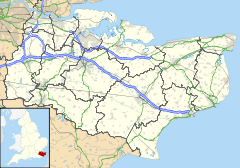Worth, Kent
| Worth | |
|---|---|
 The Crispin Inn, Worth |
|
| Worth shown within Kent | |
| Population | 992 (2011 Census) |
| OS grid reference | TR336561 |
| District | |
| Shire county | |
| Region | |
| Country | England |
| Sovereign state | United Kingdom |
| Post town | DEAL |
| Postcode district | CT14 |
| Dialling code | 01304 |
| Police | Kent |
| Fire | Kent |
| Ambulance | South East Coast |
| EU Parliament | South East England |
| UK Parliament | |
Worth is a civil parish located in the shire county of Kent and English district of Dover. Worth is situated near Sandwich, Kent, England. It has two public houses, a church, and a school. According to the 2011 UK Census, Worth had a population of 992.
Worth was supposedly first inhabited due to its fertile soils. This then eventually led to the cultivation of the land during the Norman times by the Lords of the Eastry Manor.
According to Hasted in the 18th century, Worth was made up of three boroughs, only one of which making up the current village of the 21st century, Worth Street. In the Gazetteer of the British Isles in 1887, John Bartholomew described Worth as coastal parish and village. During the sixteenth century, the area was known for its redbrick style of housing, however Worth Church, depicted below, shows the signs of Norman work from the twelfth century
The parish name of Worth is said to relate to the word Enclosure, and incorporates a description of "elements and their meanings".
C.S. Forester's fictional naval hero Horatio Hornblower was born in the village of Worth, according to Hornblower's biographer Cyril Northcote Parkinson in The Life and Times of Horatio Hornblower. According to Parkinson, the name of the small village varied in the 18th Century from Word or Worde to Worth and that a farm called the Blue Pigeons was central to the smuggling business at that time. There is today a Blue Pigeon Inn in Worth.
It is said by a local legend that Henry V was returning on the 25th October, also known as St Crispin's Day, where he had claimed victory at Agincourt, disembarking at Worth. Here he fell in love with a local "ale-wife", where they ended up living together at the local inn. supposedly as to why the The Crispin Inn (pictured) of Worth is named as it is.
The two maps below depict the same mapped view of Worth, simply one century apart. As is clear by them, mapping technique and quality vastly improved over this period. Photography made mapping a lot more simple and a lot more accurate for Ordnance Survey.
...
Wikipedia

